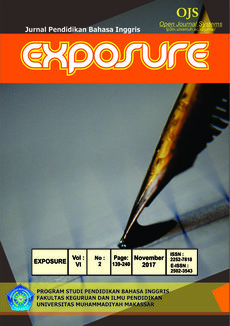A Classroom Action Research in SMA Muhammadiyah 7 Makassar: The effect of Simulation Technique in Speaking Accuracy
DOI:
https://doi.org/10.26618/exposure.v6i2.1070Abstract
This research aimed to observe and know the improvement of students’ speaking skill at the second grade Exact students of SMA Muhammadiyah 7 Makassar which amount 22 students, that covers in accuracy and fluency through Simulation Technique in Classroom Action Research (CAR).To know the students’ improvement achievement, the researcher used Diagnostic test, test cycle II, and test cycle II. Before implementing test cycle I and cycle II, the researcher applied action to the students through two cycles, which covers four meetings for each cycle.Cycle I test result had showed the improvement in the students speaking skill in the comparison with the diagnostic test, that is 3.5 (3.4 for accuracy and 3.6 for fluency) in the diagnostic test but that improvement is still not complete the standard score which is 6.5, so that the researcher continued to apply cycle II. And in the test cycle II finally the students showed the improvement significantly which is 7 for accuracy. That result proved that Simulation Technique could improve the students’ speaking skill at the second grade exact students of SMA Muhammadiyah 7 Makassar.
Heaton, J. B. 1975. Writing English Language Test. New York: Longman Inc.
Heaton, J. B. 1988. Writing English Language Test. New York: Longman Inc.
References
Crook D. (1990). Simulation, gaming, and language learning (pp. 151-158). New York: Newbury House.
Dornyei, Z. and Mhurphey, T. (2003) Group Dynamics in the Language Classroom. Cambridge: Cambridge University Press.
Gay, R.L., Mills and Airasian, P. 2006. Educational Research Competencies for Analysis and Aplication (8th edition). New Jersey: Meril Prentice Hall
Heaton, J. B. 1988. Writing English Language Test. New York: Longman Inc.
Kaplan,M.A.1997. Article. Role Playing/Simulation.http://itslj/simulation/tompkins- roleplaying.org
Moleong, J. L. 2006. Metodologi Penelitian Kualitatif. Bandung: Remaja Rosdakarya
Richard, Jack C and Renandya. 2002. Methodology in Language Teaching. New York: Cambridge University.
Riwindiasih, Susi. 2009. Collaborative Learning Model in Teaching Speaking Using Role Play Based on the School Level Based Curriculum to the First Tear Students of SMA N 1 Sragen in 2007/2008 Academic Year. Thesis FKIP Muhammadiyah University of Surakarta.
Smith, Leigh, Barbara and MacGregor, J. 1992. What Is Collaborative Learning?. Pennsylvania State University.
Widdowson, H.G. 1978. Teaching language as communication. Oxford. University press.
Downloads
Published
Issue
Section
License
Authors who publish with this journal agree to the following terms:
In order to assure the highest standards for published articles, a peer review policy is applied. In pursue of the compliance with academic standards, all parties involved in the publishing process (the authors, the editors and the editorial board and the reviewers) agree to meet the responsibilities stated below in accordance to the Journal publication ethics and malpractice statement.
Duties of Authors:
- The author(s) warrant that the submitted article is an original work, which has not been previously published, and that they have obtained an agreement from any co-author(s) prior to the manuscript’s submission;
- The author(s) should not submit articles describing essentially the same research to more than one journal;
- The authors(s) make certain that the manuscript meets the terms of the Manuscript Submission Guideline regarding appropriate academic citation and that no copyright infringement occurs;
- The authors(s) should inform the editors about any conflict of interests and report any errors they subsequently, discover in their manuscript.
Duties of Editors and the Editorial Board:
- The editors, together with the editorial board, are responsible for deciding upon the publication or rejection of the submitted manuscripts based only on their originality, significance, and relevance to the domains of the journal;
- The editors evaluate the manuscripts compliance with academic criteria, the domains of the journal and the guidelines;
- The editors must at all times respect the confidentiality of any information pertaining to the submitted manuscripts;
- The editors assign the review of each manuscript to two reviewers chosen according to their domains of expertise. The editors must take into account any conflict of interest reported by the authors and the reviewers.
- The editors must ensure that the comments and recommendations of the reviewers are sent to the author(s) in due time and that the manuscripts are returned to the editors, who take the final decision to publish them or not.
Authors are permitted and encouraged to post online a pre-publication manuscript (but not the Publisher’s final formatted PDF version of the Work) in institutional repositories or on their Websites prior to and during the submission process, as it can lead to productive exchanges, as well as earlier and greater citation of published work (see The Effect of Open Access). Any such posting made before acceptance and publication of the Work shall be updated upon publication to include a reference to the Publisher-assigned DOI (Digital Object Identifier) and a link to the online abstract for the final published Work in the Journal.

